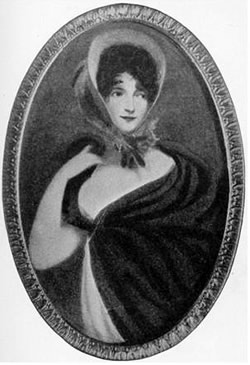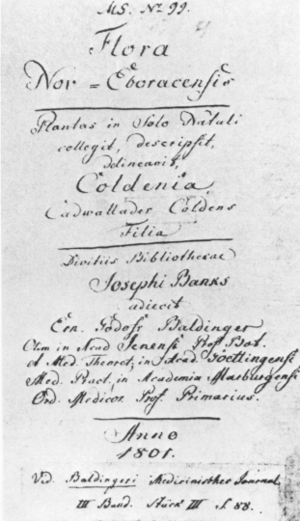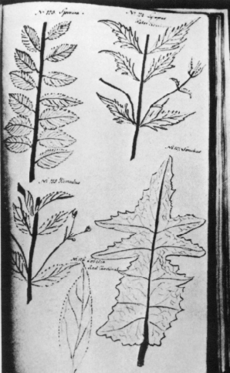Jane Colden facts for kids
Quick facts for kids
Jane Colden
|
|
|---|---|
 |
|
| Born | March 27, 1724 New York City, New York
|
| Died | March 10, 1766 (aged 41) |
| Occupation | Botanist |
| Known for | First American female botanist" |
| Spouse(s) | William Farquhar |
| Parent(s) |
|
Jane Colden (born March 27, 1724 – died March 10, 1766) was an American botanist. She is known as the first female botanist in America. A botanist is a scientist who studies plants.
Jane Colden was respected by many famous botanists of her time. These included John Bartram, Peter Collinson, Alexander Garden, and Carl Linnaeus. She is most famous for her untitled book, which is now kept in the British Museum. In this book, she described plants from the Hudson Valley area of New York state. Her book also included ink drawings of 340 different plant species.
Contents
Early Life and Learning
Jane Colden was born in New York City. She was the fifth child of Cadwallader Colden and Alice Christy Colden. Her father was a physician who later became involved in New York politics. Her mother was from an educated family in Scotland.
Jane was taught at home. Her father taught her about plants using a new system created by Carl Linnaeus. This system helped scientists classify plants. When her family moved to a large estate in Orange County, both Jane and her father became even more interested in plants. Her father was the first person to use Linnaeus's plant classification system on American plants. He also translated Linnaeus's books into English.
Because there were no special schools or gardens nearby, Jane's father helped her continue her studies. He wrote to Peter Collinson, a friend and fellow botanist, asking for books with plant pictures. He wanted Jane to keep learning about plants. Her father also made sure she met other scientists, like Peter Kalm and William Bartram.
In 1754, Jane met Alexander Garden and William Bartram. This meeting made her even more interested in botany. Jane and Alexander Garden became good friends. They wrote letters to each other, traded seeds and plants, and he taught her how to preserve butterflies. Her father wrote in a letter that Jane loved to read and was curious about nature. He said she was already describing plants using Linnaeus's system and making leaf prints.
Jane Colden's Work
Between 1753 and 1758, Jane Colden studied and listed the plants of New York. She collected samples and information on over 400 types of plants from the lower Hudson River Valley. She classified them using Linnaeus's system.
She also created a special way to make ink prints of leaves. Jane was a very skilled illustrator, making ink drawings of 340 plants. For many of her drawings, she added notes about the plants. These notes included how they could be used for cooking, in old stories, or as medicine. She even included information she learned from local Native American people.
On January 20, 1756, Peter Collinson wrote that Jane Colden had sent "several sheets of plants, very curiously anatomized after this [Linnaeus's] method." He believed she was the first woman to do such scientific work with plants. This is why she is known today as the first female botanist in America.
Jane Colden was part of a group called the Natural History Circle. In this group, she traded seeds and plants with other collectors in America and Europe. This helped her become a botanist. Through her father, she met and wrote to many important naturalists of her time, including Carl Linnaeus.
Jane discovered a new plant in 1753. It is now known as Hypericum virginicum. She wanted to name it after the famous botanist Alexander Garden. However, the name was not allowed. Another botanist, John Ellis, had already named a different plant Gardenia jasminoides after Garden. Rules for naming plants meant only one plant could be named after a person.
Even with all her achievements, no plant has ever been formally named after Jane Colden. However, a group of plants called Coldenia was named after her father.
A scientist named Brittany Kenyon-Flatt said that if Jane Colden had not been a woman, she would likely be one of the most famous early American botanists.
Colden's Plant Book
Jane Colden's plant book, which had ink drawings of leaves and plant descriptions, was never given a name by her. Her original book describing New York plants has been kept in the British Museum since the mid-1800s.
Researchers Ricketts and Hall published parts of Colden's plant descriptions in 1963. They included drawings and an index from her original book. They said her descriptions were "excellent," "full," and "careful." They believed she made them from living plants.
Colden's descriptions included details about flowers, fruits, and plant structure. She also wrote about how to use certain plants for medicine or cooking. Some descriptions mentioned the month a plant flowered and where it could be found. Her notes were written clearly and neatly. She used both Latin and common names for the plants.
Some of the plants she drew and described included Phytolacca decandra (now P. americana), Polygala senega, and Clematis virginiana. In her "Observat" (observations) section, she noted to Linnaeus that some Clematis plants only had male flowers. This shows how much time she spent observing plants carefully. Jane Colden recorded her discoveries of new plants for people in America and Europe. This shows her great love for botany and her important contributions.
A title page was added to Colden's book in 1801 by Ernst Gottfried Baldinger. He was a professor at the universities of Jena and Marburg. He wrote in Latin "Flora Nov.- Eboracensis," which means "Flora of New York" in English.
Personal Life
Jane Colden married Dr. William Farquhar in 1759. She died seven years later, at the age of 41. Her only child also died in the same year. It is not known if she continued her plant studies after she got married.
People who visited her family home noted that Jane Colden made very good cheese. She even wrote down how she made it in a document called Memorandum of Cheese made in 1756.
Legacy
Americans did not know about Jane Colden's plant book until 75 years later. Another female botanist, Almira Hart Lincoln Phelps, then said that Jane Colden was the first American woman to study botany scientifically.
The Jane Colden Memorial Garden was built in 1957 in her hometown. It was created by garden clubs from Orange and Dutchess Counties. The garden contains plants that Jane Colden had described. It is located at what is now Knox's Headquarters State Historic Site in New Windsor, close to where she lived and worked. Volunteers helped take care of the garden. In 2014, a project began to restore the garden.
See also
 In Spanish: Jane Colden para niños
In Spanish: Jane Colden para niños



